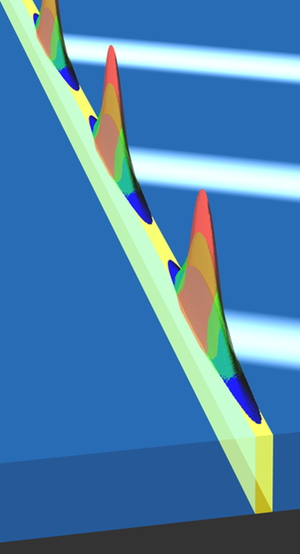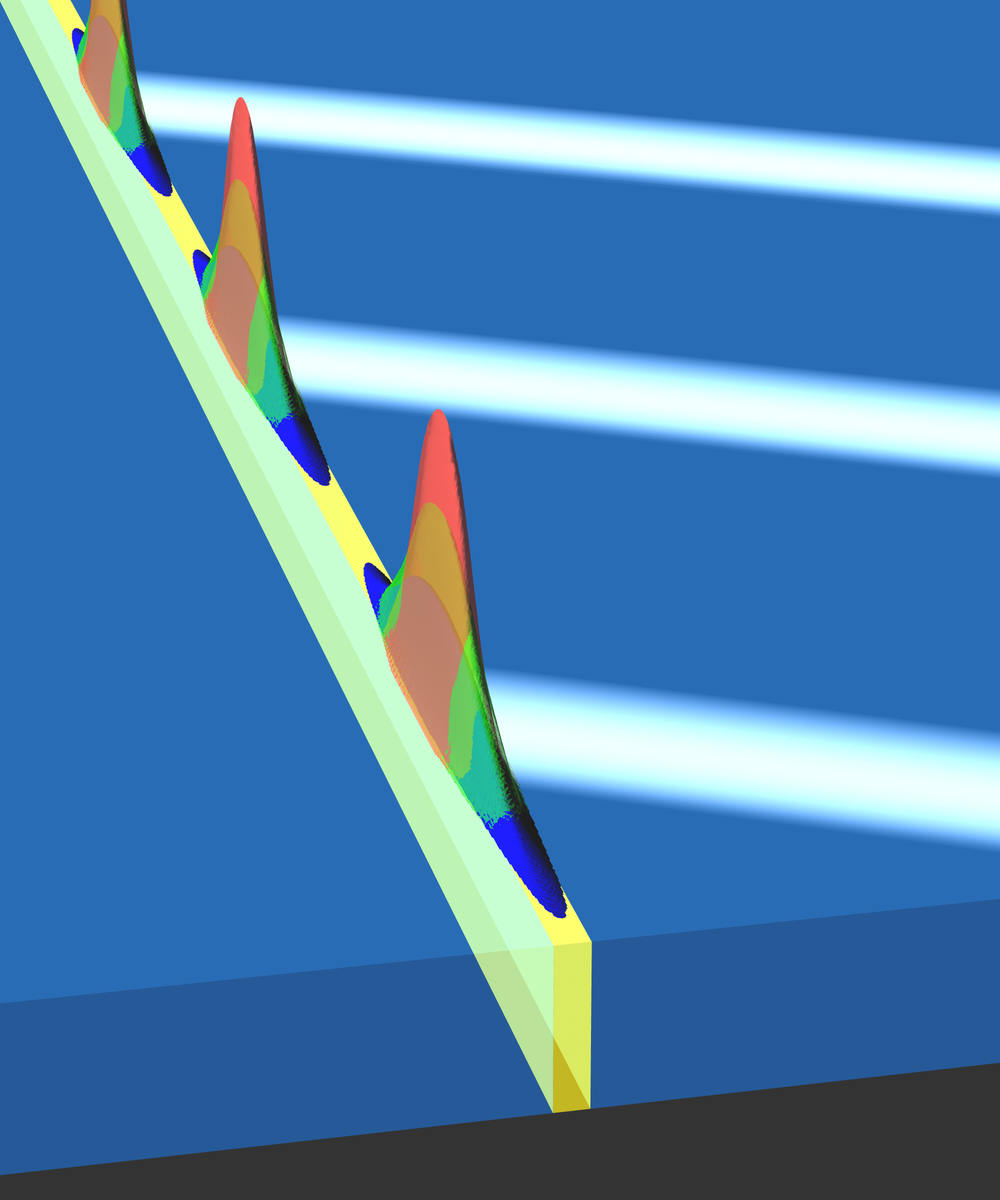Light Nearly Stopped in a Waveguide
Light can carry information at blazing speed, but processing that information in an optical network may require the light to hold still for a moment. Approaching that goal, a team writing in Physical Review Letters proposes a method they say could decelerate light pulses down to 20 meters per second in a practical nanoscale structure. This “stopped light” would occur inside a waveguide made of a long strip of silicon sandwiched between layers of another material. The pulse would die away after a short time, but it could potentially last long enough for uses such as fast optical switches, nanolasers, or highly efficient solar cells.
The first successful stopping of light occurred in a gas in which researchers used electromagnetically induced transparency, or EIT, a process where the light propagation through a material is influenced by a second light beam. Although EIT methods can slow light to zero velocity, they do so only in a very narrow range of frequencies. And the stopped light is not actually light—it gets transformed into spin states of the material’s electrons (see 15 July 2013 Viewpoint). “For many photonic applications we would like to retain the photons even at the zero-velocity point,” says Kosmas Tsakmakidis of the University of California, Berkeley. Researchers are developing other slow light methods that retain photons and that use small, practical devices, but most of them have only slowed light’s velocity by about 100 times.
One potential light-stopping system is the plasmonic waveguide, which is typically composed of multiple layers of metal and nonconducting material (dielectric) that can “guide” a pulse of light. The light can’t penetrate very far into the metal, so it propagates along the dielectric-metal interfaces in certain configurations, or modes, determined by the material structure and by the way the light is introduced into the waveguide.
Tsakmakidis, team leader Ortwin Hess of Imperial College London, and another colleague previously proposed stopping light with plasmonic waveguides containing metamaterials [1]. These composites can bend light sharply, so it travels almost in reverse when it crosses an interface. The prediction was that several “zero-velocity” modes exist in which light travels in a loop, cycling between going one direction in a dielectric layer and going the reverse direction in the neighboring metamaterial layer. Other groups tried similar designs [2], but researchers realized that photon losses due to scattering and absorption caused most of the zero-velocity modes to disappear, leaving only one mode—a so-called complex-frequency mode—that is not easily excited in waveguides.
Tsakmakidis, Hess, and their collaborators have now devised a way to excite the complex-frequency, zero-velocity mode in a simple waveguide. Their design doesn’t require any difficult-to-construct metamaterials but instead has a 300-nanometer-thick slab of silicon sandwiched between two layers of (metallic) indium tin oxide, or ITO. For infrared light of a particular polarization, ITO behaves like a metamaterial, causing light waves to bend backwards and reverse direction whenever they cross the silicon-ITO boundary. To excite modes in this waveguide, the team imagined injecting polarized, near-infrared light pulses through one of the ITO layers, which is thin enough (500 nanometers) that light gets through. By adjusting the angle of incidence of the input pulses, the team could tune the wavelength of the light in the waveguide and excite only the desired zero-velocity mode. In numerical computations, this mode only advanced a few picometers in 100 femtoseconds, which implies a deceleration factor of 15 million.
Due to photon losses, the stopped light pulse lasted only 130 femtoseconds. But that lifetime is long enough for some nanophotonic applications, Tsakmakidis says, and extending the lifetime may be possible by adding a gain medium into the waveguide [3]. He says that stopping light and concentrating it in one spot could benefit, for example, the conversion of light into electricity in photovoltaics.
“This theoretical work is very impressive, since the authors revealed that an extremely slow light mode can be realized, in principle, in a practical planar waveguide structure,” says Qiaoqiang Gan of the State University of New York at Buffalo. Using the system in solar cells may be challenging because it relies on the angle and polarization of the input pulses, he says. But he believes one unique advantage of the system is that it appears less sensitive to imperfections such as surface roughness, compared with previous stopped light designs.
–Michael Schirber
Michael Schirber is a Corresponding Editor for Physics Magazine based in Lyon, France.
References
- K. L. Tsakmakidis, A. D. Boardman, and O. Hess, “‘Trapped Rainbow’ Storage of Light in Metamaterials,” Nature 450, 397 (2007)
- Q. Gan, Z. Fu, Y. J. Ding, and F. J. Bartoli, “Ultrawide-Bandwidth Slow-Light System Based on THz Plasmonic Graded Metallic Grating Structures,” Phys. Rev. Lett. 100, 256803 (2008)
- O. Hess and K. L. Tsakmakidis, “Metamaterials with Quantum Gain,” Science 339, 654 (2013)





